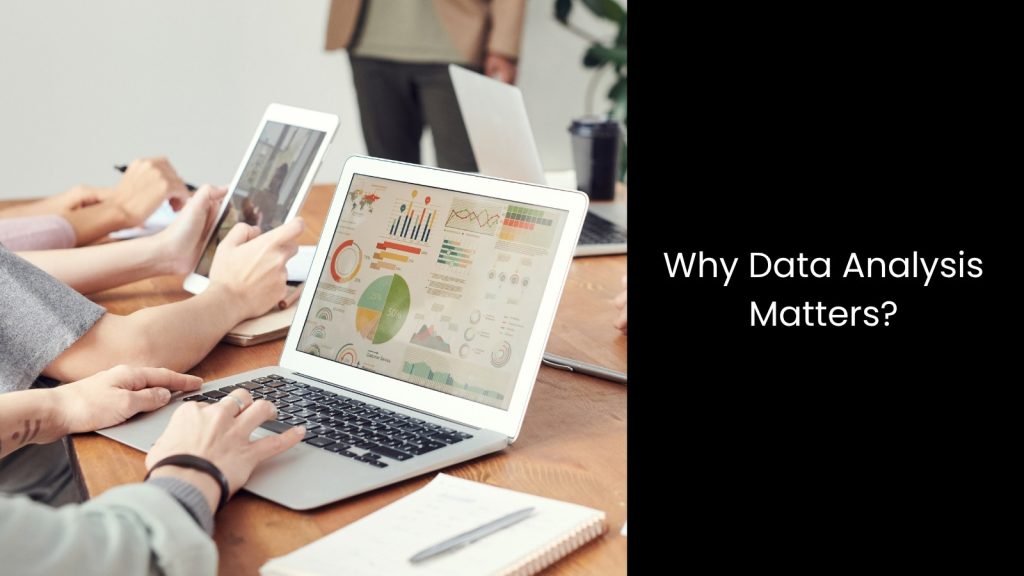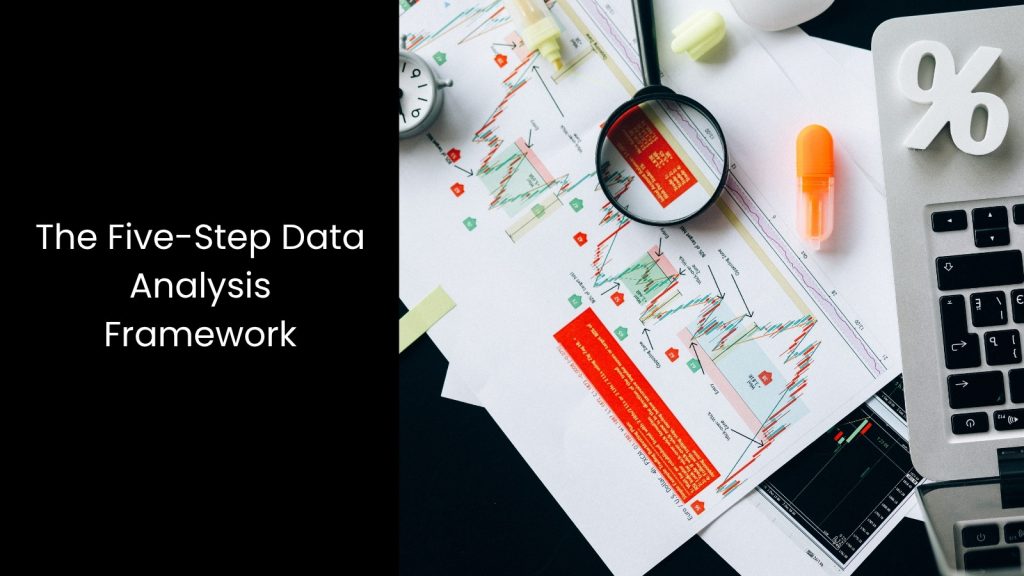Every day, people and companies collect massive amounts of data, but not everyone knows how to make sense of it. That is where the five-step data analysis framework comes in. It gives a clear path to turn messy data into useful answers. From asking the right question to taking action based on what the data shows, each step plays a key role. Whether you want to improve a product, understand customer behaviour, or solve a complex problem, this process helps simplify it.
Let us give you a closer look at how these five steps guide smarter, faster, and more confident decision-making.
We will discover
Why Data Analysis Matters?

- As you can see, today, businesses swim in a sea of data. Every click, scroll, and purchase leaves a trail.
- Without data analysis, companies just guess and hope for the best. That is where problems start.
- A decision based on gut feeling might feel right at first but could lead to wasted time, lost money, or missed chances. On the flip side, data-backed choices cut down risks and point the business in a smart direction.
- As the digital world keeps growing, data keeps piling up. This nonstop explosion of information can feel overwhelming, especially when competitors move fast and fight for every customer. So, businesses must use data not just to keep up but to stay ahead.
- When you analyse data, you stop guessing and start understanding what works, what does not, and what to fix. You turn patterns into action. That kind of clarity builds confidence. It pushes smart moves, not lucky ones.
- With pressure rising in every market, the edge belongs to those who read their data well.
The Five-Step Data Analysis Framework

Step 1 – Frame the Business Question
The first step in the five-step data analysis framework asks you to frame the business question. This part sets the direction for everything that follows. Without a clear question, your data becomes just numbers with no meaning.
Instead of jumping straight into graphs and charts, take a step back and ask, ‘What do we need to find out?’. That question might sound simple, but it carries a lot of weight. A well-framed question points the entire team toward a goal that matters. It could be something like, ‘Why are sales dropping in one region?’ or ‘Which type of customer buys more often?’.
The goal is not just to collect facts; it is to solve real business problems with answers that make sense. People usually make the mistake of skipping this step, and then they wonder why the data feels confusing. Framing the question adds direction. It shapes your focus and saves time later.
It also keeps everyone on the same page, from analysts to managers. When you ask the right question from the start, you give your data a purpose. That is how you stop wandering in circles and start making smart decisions. So, before touching a single spreadsheet, pause and think. What exactly do we want to know?
Step 2 – Acquire and Integrate Data
Once you nail the question, you move to step two: Acquire and Integrate Data.
Start with first-party data, the information your website, app, or cash register records about customers. Next comes second-party data, which a trusted partner shares with you, like two stores swapping loyalty-card insights. Last sits third-party data, bought from outside sellers who bundle facts from many sources.
Now you need a data warehouse or data lake that stores everything together so you do not chase files across ten systems. Warehouses handle neat, structured tables; lakes welcome messy, raw files like logs or photos. To fill those storage spots, you extract, transform, and load (ETL) or extract, load, and transform (ELT). ETL cleans the data first, then sends it in. ELT loads the raw stuff straight away and cleans it on demand, which is handy when teams want flexible experiments.
You do not have to lug buckets of data on foot. There are many tools that act like conveyor belts that pull records from SaaS apps, databases, or spreadsheets on a schedule.
Also, central storage creates a single source of truth. Everyone, from interns to executives, reads the same numbers, which avoids meetings where dashboards disagree. Good governance then steps in. You set rules for who may view, update, or delete each dataset; you log changes; and you monitor quality.
Step 3 – Clean, Transform and Model Data
Step three is where you prepare every sample for truth-telling.
First, run data-quality checks. You scan for duplicates that can double-count revenue, hunt nulls that leave blanks in the story, and flag outliers that stretch reality, such as a customer who somehow placed ten thousand orders in a minute. Next, dive into transformation. You normalise values so every price tag speaks the same currency and every date follows the same clock. You join tables to stitch customer details with order facts, turning scattered fragments into a single canvas.
Then you craft fresh features that sharpen future models. After cleaning and shaping, you need a solid modelling layer. Tools give you version-controlled SQL scripts that build repeatable, readable models inside the warehouse. If you prefer hand-rolled SQL, you can group scripts into layers: staging for raw copies, intermediate for business logic, and final for analytics-ready views.
Document each step, add tests that fail loudly when data drifts, and keep every transformation transparent so teammates can trace a number back to its source. When you skip a quality rule, you invite skewed insights that push teams toward wrong moves. Thorough cleaning and thoughtful modelling guard against that trap, making sure later charts and forecasts rest on solid ground.
Step 4 – Analyse and Test Hypotheses
This is where you ask, ‘What is going on?’ and ‘What should we do next?’.
You start with four main types of analysis. Descriptive tells you what happened, like how many users clicked an ad. Diagnostic digs deeper into why it happened; maybe clicks dropped because a sale ended. Predictive looks ahead, like guessing future traffic. Prescriptive points direct you toward action, like increasing the budget on a top-performing channel.
Now, picking the right method matters. A/B tests compare two versions, which is great for testing an email subject line or a homepage banner. Regression spots trends between variables, like how price affects sales. Clustering groups things, like shoppers with similar habits. Forecasting uses past data to guess what is coming next, such as monthly sales.
If you want to know if influencer ads work better than Facebook ads, you can run an A/B test with equal budgets. Then check click-through rates, conversions, and total return. However, do not expect perfect answers right away. You may need to repeat the test, fine-tune your approach, or ask a teammate from marketing or finance to weigh in.
Always share results for review. Fresh eyes help catch mistakes or suggest new angles. Testing, questioning, and adjusting push you toward smarter conclusions. This step does not just crunch numbers; it helps the business choose its next move with sharp insight instead of gut feeling. It builds clarity from curiosity and turns raw data into useful decisions.
Step 5 – Communicate Insights and Drive Action
Step five turns raw facts into choices people follow. A sharp story runs on three rules: clarity, context, and visuals.
Clarity swaps jargon for plain talk, trimming giant tables into key points. Context ties every metric to a goal, like linking a 10% bounce drop to thirty extra sales a day. Visuals push the lesson deeper; a heat map or bar chart lands faster than a wall of numbers and sticks in memory.
Next, pick the right stage for the show. Robust tools will let you build dashboards that either freeze a snapshot in time or refresh every hour for a live pulse. Static boards suit quarterly reviews when leaders want a tidy summary. Real-time boards guide daily stand-ups where teams must spot shifts the moment they appear. You can even mix both styles so each group works at its own rhythm.
Finally, you must plan follow-up checks to see whether actions hit the mark or need a tweak. This loop keeps insight fresh and stops slides from gathering dust. When executives absorb lessons in seconds, they back bold moves with confidence, and the analysis lives on instead of fading into another forgotten report.
Building a Data-Driven Culture with the Right Technologies

A data-driven culture starts with a mindset but thrives through the right Business Intelligence Systems. When teams trust data and use smart tech to explore it, every decision gains weight and direction. Keep the focus on clean processes, cross-team access, and constant learning. With the right technologies through a reputable partner in place, your business will not just react; it will anticipate, act faster, and grow smarter every step.

